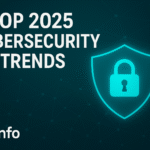Introduction
Cyber threats are evolving rapidly, and businesses cannot afford to stay unprepared. In 2025, organizations of all sizes will face more advanced ransomware, AI-powered attacks, supply chain risks, and cloud security challenges. Preparing for these risks is no longer optional; it has become a survival necessity.
This article examines practical strategies that businesses can adopt to prepare for 2025 cyber threats, thereby ensuring stronger defenses, compliance, and resilience.
1. Strengthen Identity and Access Management (IAM)
One of the most common entry points for attackers is weak credentials. To prepare, businesses should:
- Adopt multi-factor authentication (MFA) across all critical systems.
- Move towards passwordless authentication with biometrics.
- Implement a zero-trust framework, ensuring every user and device is verified continuously.
By securing access points, organizations reduce the risk of stolen credentials leading to full-scale breaches.
2. Invest in AI-Driven Cybersecurity Tools
Cybercriminals are using artificial intelligence to create sophisticated phishing campaigns and malware. Businesses need to fight fire with fire. In 2025:
- AI-powered tools can detect unusual behavior in networks.
- Automated systems can respond instantly to attacks, reducing downtime.
- Machine learning models can predict potential vulnerabilities before they’re exploited.
This proactive approach is key to staying ahead of threats.
3. Prepare for Post-Quantum Security
Quantum computing may break today’s encryption methods in the near future. Businesses should:
- Start exploring post-quantum cryptography solutions.
- Work with vendors adopting quantum-safe algorithms.
- Protect long-term sensitive data that could be “harvested now and decrypted later.”
Preparing now ensures businesses don’t fall behind once quantum advancements accelerate.
4. Secure Cloud and Hybrid Environments
Most companies now rely on cloud platforms, but misconfigured systems are a top target. To strengthen cloud security:
- Use Cloud Security Posture Management (CSPM) tools.
- Regularly audit permissions and access controls.
- Encrypt sensitive data both in transit and at rest.
By securing hybrid and multi-cloud setups, businesses can avoid costly breaches.
5. Build Supply Chain Cyber Resilience
Attacks on third-party vendors can be devastating. Businesses should:
- Vet partners and suppliers for strong security practices.
- Require vendors to follow strict compliance policies.
- Monitor supply chain activity for suspicious patterns.
This reduces exposure from weak links in external partnerships.
6. Train Employees for Cyber Awareness
Human error is still the biggest risk in cybersecurity. In 2025, businesses must:
- Conduct regular phishing simulations to test employee awareness.
- Offer training sessions on safe online behavior.
- Build a security-first workplace culture where staff report threats immediately.
An informed workforce is the strongest line of defense.
7. Expand Cyber Insurance Coverage
As threats grow, cyber insurance is becoming essential. Businesses preparing for 2025 should:
- Review policies to ensure coverage against ransomware, data loss, and downtime.
- Meet insurance providers’ requirements (MFA, backups, compliance).
- Treat cyber insurance as a backup safety net, not a replacement for strong security.
This protects against financial losses if an attack occurs.
8. Ensure Regulatory Compliance
Governments worldwide are tightening rules around data protection. To avoid penalties:
- Stay updated on laws like GDPR, CCPA, and emerging local regulations.
- Keep compliance documentation updated for audits.
- Use compliance automation tools to reduce manual work.
Being compliant not only avoids fines but also builds customer trust.
9. Improve Incident Response & Recovery Plans
Even with strong defenses, attacks can still happen. Businesses need:
- A tested incident response plan that outlines roles and actions.
- Regular backups stored in secure, offline locations.
- Business continuity plans to ensure quick recovery.
Being prepared minimizes downtime and reputational damage.
10. Monitor Emerging Threats Continuously
Cybersecurity is not a one-time setup. In 2025, threats will evolve daily. Businesses should:
- Subscribe to cyber threat intelligence feeds.
- Join industry security groups for shared insights.
- Update firewalls, software, and antivirus tools frequently.
Staying updated means staying protected.
Conclusion
Cyber threats in 2025 will be more advanced, targeted, and costly. Businesses that take proactive steps now to secure identities, train employees, adopt AI tools, and strengthen cloud and supply chain defenses will be far better equipped to face the future.
The best strategy is a layered defense, combining technology, human awareness, compliance, and insurance. By preparing today, businesses can protect their data, reputation, and financial stability tomorrow.



